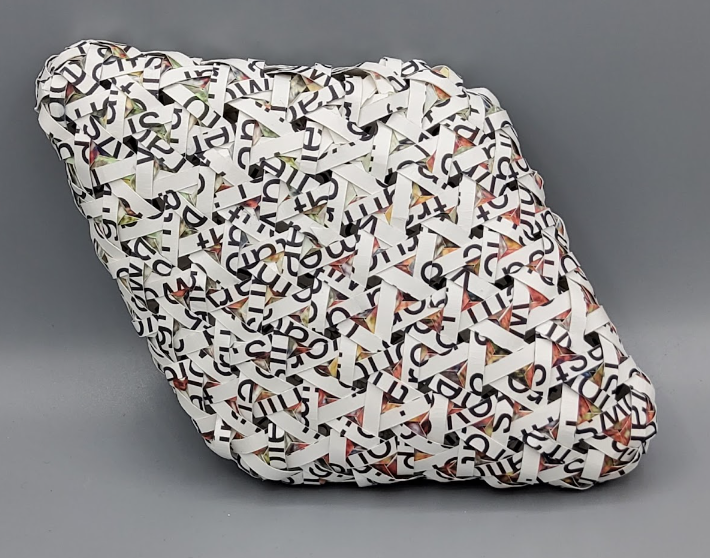Last month I introduced my variant of the 100 day challenge. My method, constraints and goals remain the same.
#14 – Attempting more control

#15 – pen with watercolour drawing, wash over.
According to my notes this was based on Michele Webber video(s).

#16 – using Akim script. Text from a letter by my dad, who loved bushwalking and bird watching. I put buttons on the drying base, but the texture is hardly visible.

#17 – Clingfilm gathered in lines over drying paint. Splatter.

#18 – Crushed clingfilm over drying paint. Dip pen & watercolour marking over. The “feature” colour of this sample is Opal Blue. Over the project I’ve come to see the “shiny” colours as a particular strength and opportunity in the range. There are nine metallics, six pearls and six opals, and they can really bring some zing.

#19 More controlled washes.
I’ve been watching so many YouTube videos, and there is such an overlap, that I haven’t been able to credit everything. However this is definitely based on a Natasha Newton video.

#20 – wet paint moved by blowing with a straw

#21 – table salt sprinkled over drying paint

#22 – Given the chosen constraints, I’ve found myself taking more and more liberties with the concept of “matching” colours. In this case both the paint and the colour book used the name “Cerulean Blue” for distinctly different colours. This was painted wet on wet, with a stencil put on the surface as it dried. I’m sure others use this technique, but I haven’t seen it around so regard it as “my invention”.

#23 – The Yellow Gold paint was matched to Yellow Orange in the colour book (which doesn’t include any metallics). It was painted onto an old wooden textile printing block and stamped over the dry base colours.

#24 – Mark making with a dry brush

#25 – Sanzo Wada’s second volume of color combinations includes some photos of inspiration items. This design is based on the original cloth.

#26 – Watercolour bubbles, using detergent liquid. There are quite a few video channels showing this technique.

#27 – Some cut strips of craft foam were used as masks. Watercolour dabbed on using cosmetic sponge.

#28 – Base used wet on wet, with brush end used to create marks. A wooden textile block was stamped over the dry paint. On the left a full print using the feature “Graphite Red”. On the right the same block, with selected areas painted with green.

#29 – The base was crinkled clingfilm over drying paint. The feature colour was Opal Green, applied using the bubble technique. I hoped darker colours in the background would highlight the opal bubble texture, however the base layer was reactivated as the bubbles dried. In life the opal appears more as a sheen.

#30 – This was another swatch influenced by an image in the colour book. The marks are influenced by Kory’s Art Cafe. The feature colour is Pearl Scarlet Red – almost all the colour lost in the photograph, but not the original.

#31 – Candle wax as a resist. Love the texture

#32 – Another stencil laid on wet paint. The stencil is a field of thickly outlined circles, which didn’t move the paint as well as the thin circles of #22. Of course lots of other factors may have been in play.

#33 – Based on a colour book image. Definitely not working with my strengths.

#34 – I love the colours and textures of this. The thinner stencil lines worked well, as I’d hoped. However a big technical fail. All the earlier stencils I’ve tried were cut from yupo. This one was cardstock – and stuck to the page. I’ll have to recut it (yay for having a Silhouette Cameo!).

#35 – This used Steve Mitchell’s wet on dry technique for spontaneous watercolours, as shown on the Strathmore Papers channel. Fascinating.

#36 – More wet on dry, with greater colour contrast.

#37 And again! This time the tricky red-green colour palette was able to avoid Christmassy vibes.
To me the Akim script works well in combination, providing more texture and not easily read. The text is a quote from Charlotte Wood.

#38 – Another wet on wet with (yupo!) stencil laid over. I scribbled some marks into the wet paint using a brush end.

#39 – another wooden block, stamped multiple times and deliberately not registered.
It’s very difficult to see in the photo, but opal pink was used on just the flower of the block, and stamped in the spaces between the main prints. In life it gives a subtle damask effect.


#40 – This uses a technique from Ginger McElfresh, removing dry watercolour with a baby wipe through a stencil.

#41 – Another wet on dry. Oh I love this technique. The feature colour was Blue Gold, which I matched to Ivory Buff in the colour book. I kept the colour palette simple – the gold, and a combination of Purple and Cobalt Violet – some mixed in the palette, some on the page. It’s so pretty.

#42 – I used a dip pen, with watercolour applied to the nib with a brush (as in some previous swatches). The marks are based on letters from the Akim script.

That brings me up to date (today’s swatch is still in progress). After a bumpy period I’m more regular with the daily rhythm. A few techniques I want to take further:
- Akim script
- to add text
- forms repeated to create texture
- Stencils
- on drying paint
- to remove dried paint
- Spontaneous wet on dry






















































































































